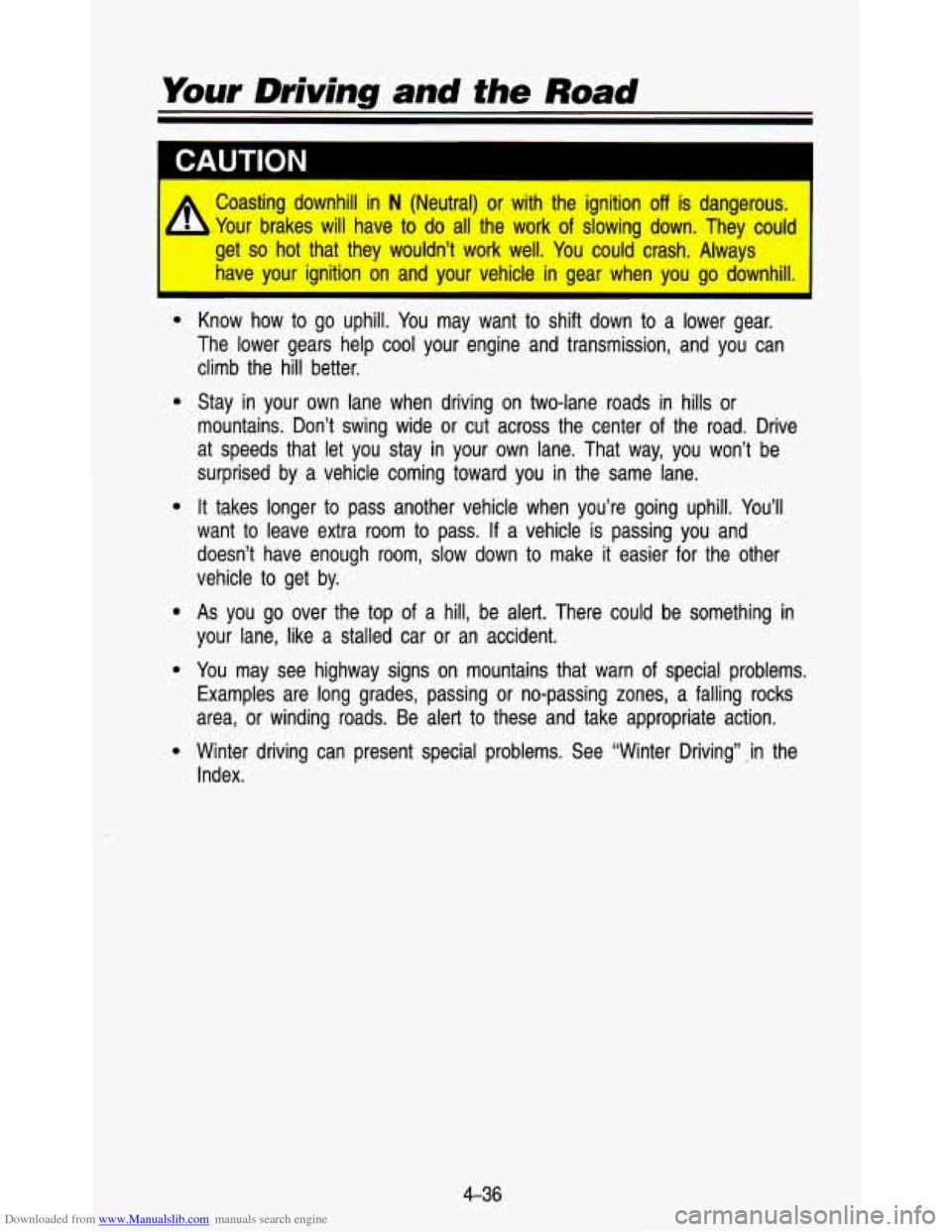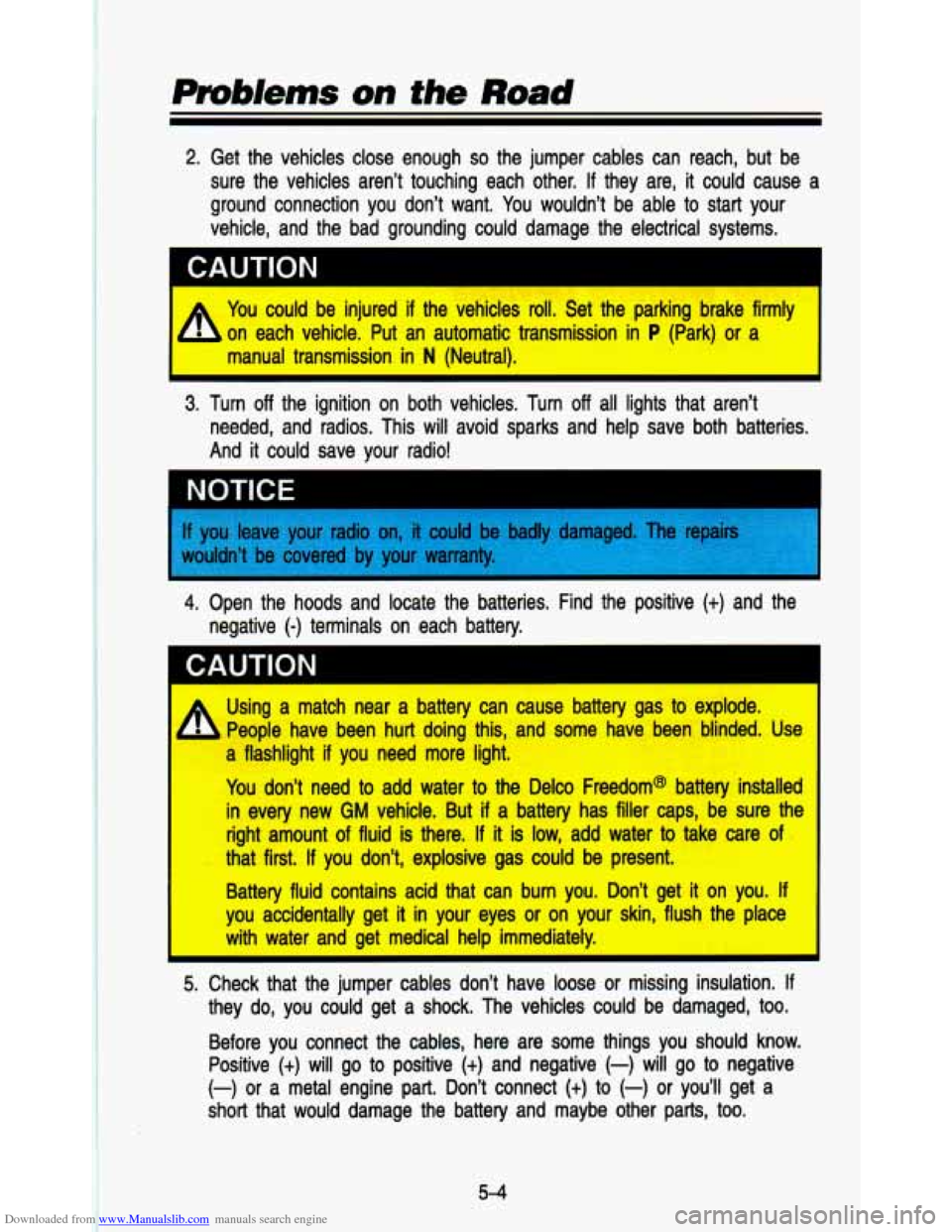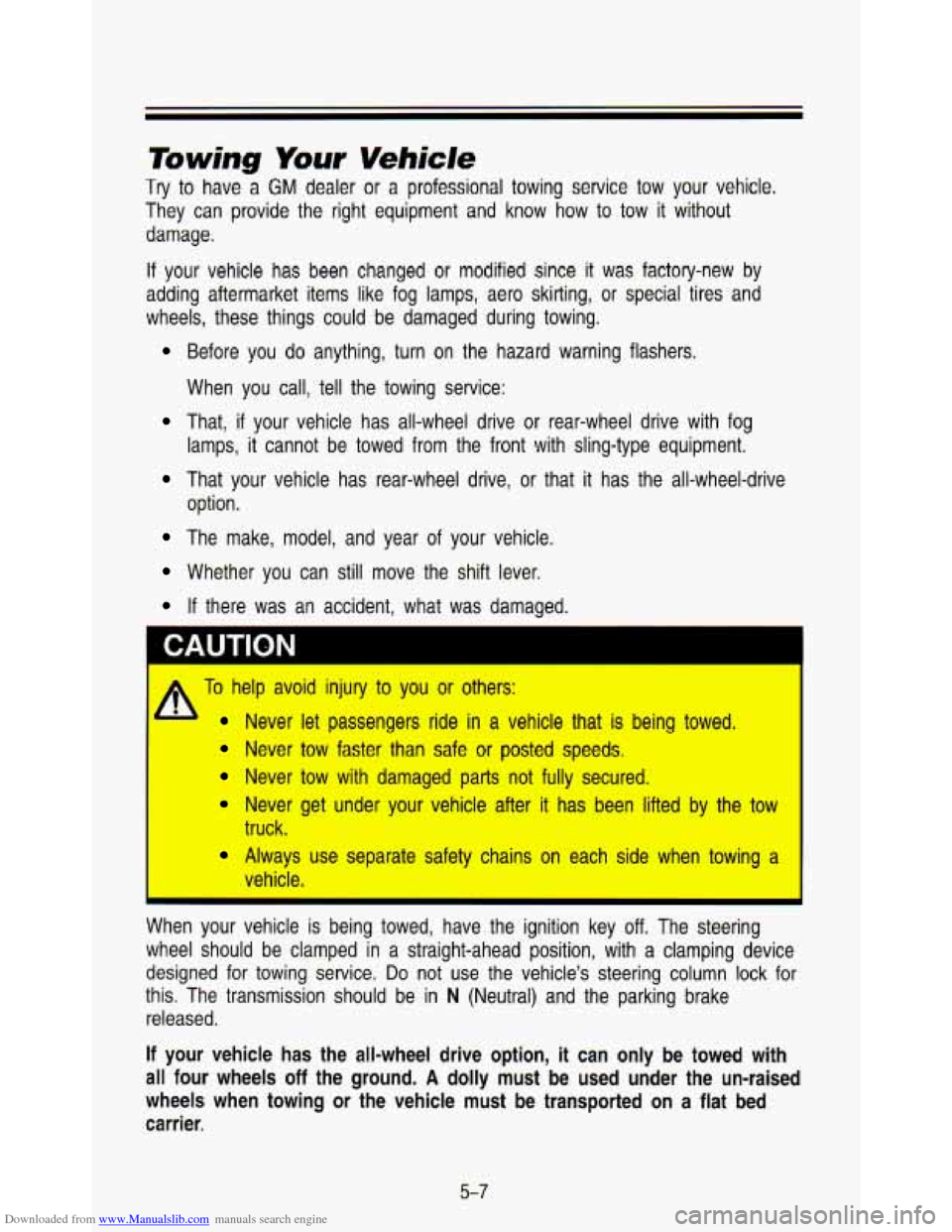1993 CHEVROLET ASTRO PASSENGER ignition
[x] Cancel search: ignitionPage 190 of 345

Downloaded from www.Manualslib.com manuals search engine Your Driving and the Road
I
CAUTION 1
A
Coasting downhill in N (Neutral) or with the ignition off is dangerous.
Your brakes
will have to do all the work of slowing down. They could
get
so hot that they wouldn’t work well. You could crash. Always
have vour ignition on and vour vehicle in aear when you go downhill.
--
Know how to go uphill. You may want to shift down to a lower gear.
The lower gears help cool your engine and transmission, and you can
climb the hill better.
Stay in your own lane when driving on two-lane roads in hills or
mountains. Don’t swing wide or cut across the center of the\
road. Drive
at speeds that let you stay in your own lane. That way, you won’t be
surprised by a vehicle coming toward you in the same lane.
It takes longer to pass another vehicle when you’re going uphill. You’ll
want to leave extra room to pass.
If a vehicle is passing you and
doesn’t have enough room, slow down to make it easier for the other
vehicle to get by.
As you go over the top of a hill, be alert. There could be something in
your lane, like a stalled car or an accident.
You may see highway signs on mountains that warn
of special problems.
Examples are long grades, passing or no-passing zones, a fallin\
g rocks
area, or winding roads. Be alert
to these and take appropriate action.
Winter driving can present special problems. See “Winter Driv\
ing” ,,in the
Index.
4-36
Page 208 of 345

Downloaded from www.Manualslib.com manuals search engine 2. Get the vehicles close enough so the jumper cables can reach, but be
sure the vehicles aren’t touching each other.
If they are, it could cause a
ground .connection you don’t want. You wouldn’t be able
to start your
vehicle, and the bad grounding could damage the electrical syst\
ems.
1 CAUTION
I
A You could be injured if the vehicles roll. Set the parking brake firmly
b on each vehicle. Put an automatic transmission in P (Park) or a
I manual transmission in N (Neutral).
3. Turn off the ignition on both vehicles. Turn off all lights that aren’t
needed, and radios. This will avoid sparks and help save both \
batteries.
And
it could save your radio!
1’ NOTICE
Iv dar li 1. The Pairs f you leave your radio on, it could be t
Nouldn’t be covered bv vour warrallLv I
4. Open the hoods and locate the batteries. Find the positive (t) and the
negative
(-) terminals on each battery.
1 CAUTION
A Using a match near a battery can cause battery gas to explode.
People have been hurt doing this, and some have been blinded. \
Use
a flashlight
if you need more light.
You don’t need
to add water to the Delco Freedom@ battery installed
in every new
GM vehicle. But if a battery has filler caps, be sure the
right amount of fluid is there.
If it is low, add water to take care of
that first. If you don’t, explosive gas could be present.
Battery fluid contains acid that can burn you. Don’t get
it on you. If
you accidentally get it in your eyes or on your skin, flush the place
I with water and get medical help immediately.
5. Check that the jumper cables don’t have loose or missing in\
sulation. If
they do, you could get a shock. The vehicles could be damaged\
, too.
Before you connect the cables, here are some things you should\
know.
Positive
(t) will go to positive (+) and negative (-) will go to negative
(-) or a metal engine part. Don’t connect (t) to (-) or you’ll get a
short that would damage the battery and maybe other parts,
too.
5-4
Page 211 of 345

Downloaded from www.Manualslib.com manuals search engine Towing Your Vehicle
Try to have a GM dealer or a professional towing service tow your vehicle.
They can provide the right equipment and know how to tow it without
damage.
If your vehicle has been changed or modified since it was factory-new by
adding aftermarket items like fog lamps, aero skirting, or special tires and
wheels, these things could be damaged during towing.
Before you do anything, turn on the hazard warning flashers.
When you call, tell the towing service:
That, if your vehicle has all-wheel drive or rear-wheel drive with fog
lamps, it cannot be towed from the front with sling-type equipment.
That your vehicle has rear-wheel drive, or that it has the all-wheel-drive
option.
The make, model, and year of your vehicle.
Whether you can still move the shift lever.
If there was an accident, what was damaged.
* To help avoid injury to you or others:
I
Never let passengers ride in a vehicle that is being towed.
Never tow faster than safe or posted speeds.
Never tow with damaged parts not fully secured.
Never get under your vehicle after it has been lifted by the tow
Always use separate safety chains on each side when towing a
truck.
I vehicle.
When your vehicle is being towed, have the ignition key
off. The steering
wheel should be clamped in a straight-ahead position, with a clamping device
designed
for towing service. Do not use the vehicle’s steering column lock for
this. The transmission should be in
N (Neutral) and the parking brake
released.
If your vehicle has the all-wheel drive option, it can only be towed with
all four wheels
off the ground. A dolly must be used under the un-raised
wheels when towing or the vehicle must be transported
on a flat bed
carrier.
5-7
Page 339 of 345

Downloaded from www.Manualslib.com manuals search engine ..
.
E
Engine Block Heater
..................... 2.16. 3-9
Coolant
............................ 5.11. 6-26
Coolant Temperature Gage
...... 2-60
Cover
......................................... 6-1 5
Exhaust ............................ 2.24. 6-41
Fan Noise
.................................. 5-1 6
Identification
..................... 6.60. 6-64
Oil (See “Oil”) Overheating
................................. 5-8
Running While Parked
... 2.22. 2-25
Equipment. Add-on
...................... 6-44
Exhaust System
............................ 6-41
F
Finish Care
........................................... 6-56
Damage
..................................... 6-57
Automatic Transmission
............ 6-20
Brake
......................................... 6-32
Capacities
.................................. 6-64
Coolant
............................ 5.11. 6-26
Leak Check
............................... 6-34
Power Steering
......................... 6-30
Transfer Case
........................... 6-23
Windshield Washer
................... 6-31
Fog Lamps
.................................... 2-42
Four-wheel Antilock
..................... 4-1 5
Front Seats ..................................... 1-2
Fuel
................................................. 6-4
Gage
.......................................... 2-63
In Foreign Countries
................... 6-6
Regulator
................................... 2-1 5
Tank Capacity ........................... 6-65
Fuse Block
.................................... 6-63
Fuses and Circuit Breakers
......... 6-68
Fluid
Filling Your Tank
......................... 6-6
G
Gages
Fuel ............................................ 2-63 ....
Voltmeter .................................... 2-64
Gasolines for Cleaner Air
.............. 6-5
H
Hatch Release Switch .................. 2-27
Hazard Warning Flashers
.............. 5-2
Head Restraints
............................ 1-11
Headlights
...................................... 6-35
High Beams
..................... 2.66. 4-24
High-Low Beam
......................... 2-31
Reminder Light
.......................... 2-44
Heating System
.............................. 3-5
Fan Lever
.................................... 3-5
Rear
............................................. 3-7
Temperature Lever
...................... 3-5
Highway Hypnosis
........................ 4-34
Hitches Hood Block Heater.,
............................ 2-16
Function Lever
............................ 3-5
4-46
...........................................
Latches and Hinge ................... 6-40
Release
........................................ 6-8
Horn
............................................... 2-28
Hydroplaning
................................. 4-27
I
If You’re Stuck in Sand. Mud.
Ice or Snow
.............................. 5-32
Ignition Switch
............................... 2-13
Inflation-Tire Pressure
................... 6-45
Instrument Cluster
........................ 2-52
Standard
.................................... 2-55
Digital
......................................... 2-52
J
Jack Storage ................................. 5-18
Jump Starting
.................................. 5-3
9-3